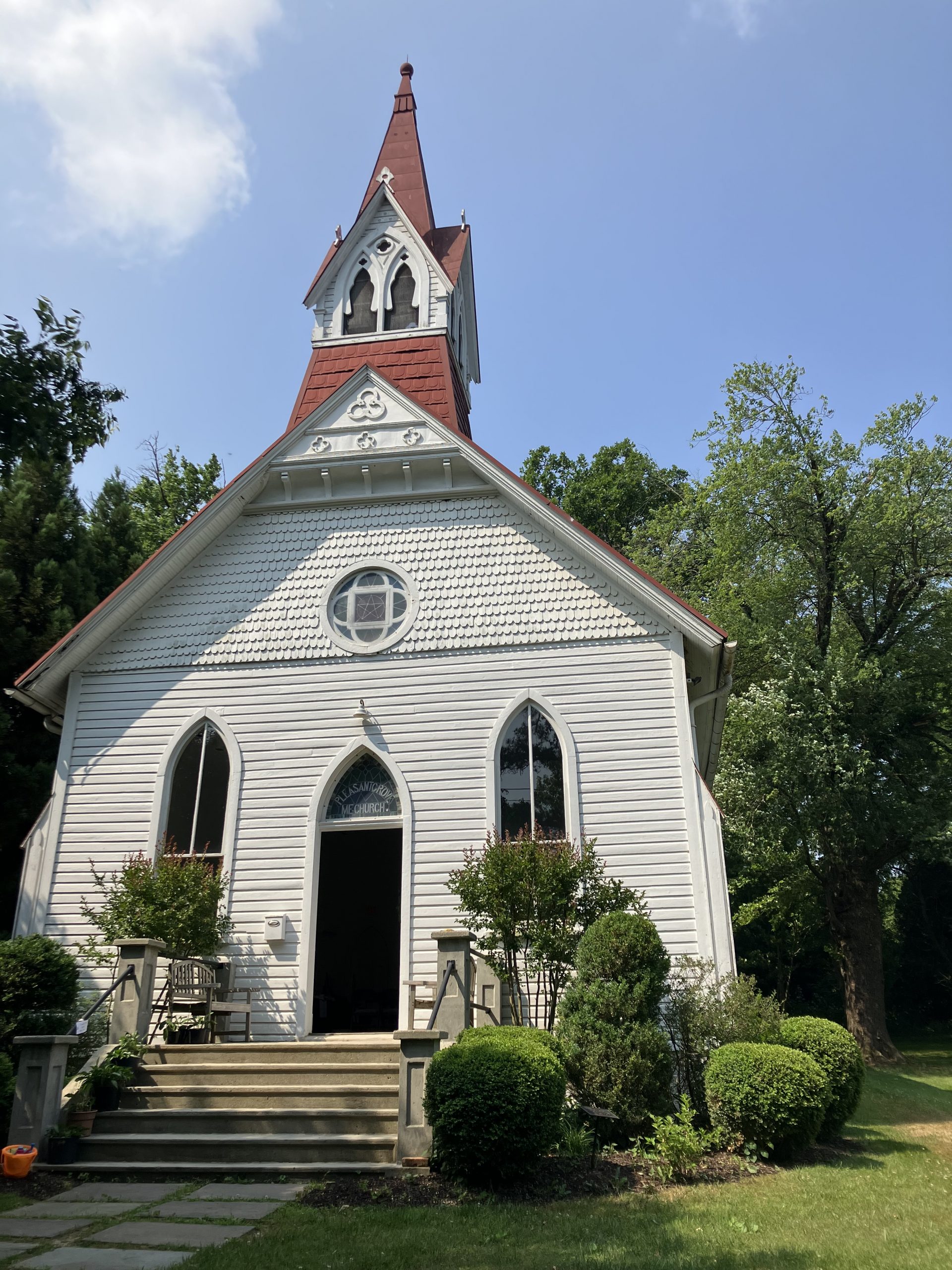
On Saturday, June 17, Historic Pleasant Grove Church, an historic site and museum, held their annual Spring Fair and Open House. Pleasant Grove is located at 8641 Lewinsville Road, McLean, Virginia 22102, just on the outskirts of Tysons.
As described on their website: “Historic Pleasant Grove is a community landmark in McLean, Virginia built by and for African and Native Americans in the late 19th century. No longer an active church, the simple-yet-striking Carpenter Gothic structure is an historic site managed by the Friends of Pleasant Grove, who foster diversity through free cultural events throughout the year, operate the on-site museum, and rent the space.”
Some of Pleasant Grove’s founding families’ members are buried on the property, including members of the Sharper family. On the day of the open house, I took time to really appreciate the Carpenter Gothic Architecture and craftmanship of Lewis Henry Sharper, the master carpenter who led much of the work on the building. I also learned that among Pleasant Grove’s founding families were members of the Pamunkey Native American Tribe, including John Mills who also helped build the structure.
My husband, Tyler, and I (and our dog Scrappy) were also pleased to speak with Michelle Arcari, Board President of the Friends of Pleasant Grove. We learned about the history of the organization, their on-going work to preserve the structure and the history of the community, as well as their efforts to promote cultural diversity through events held throughout the year.
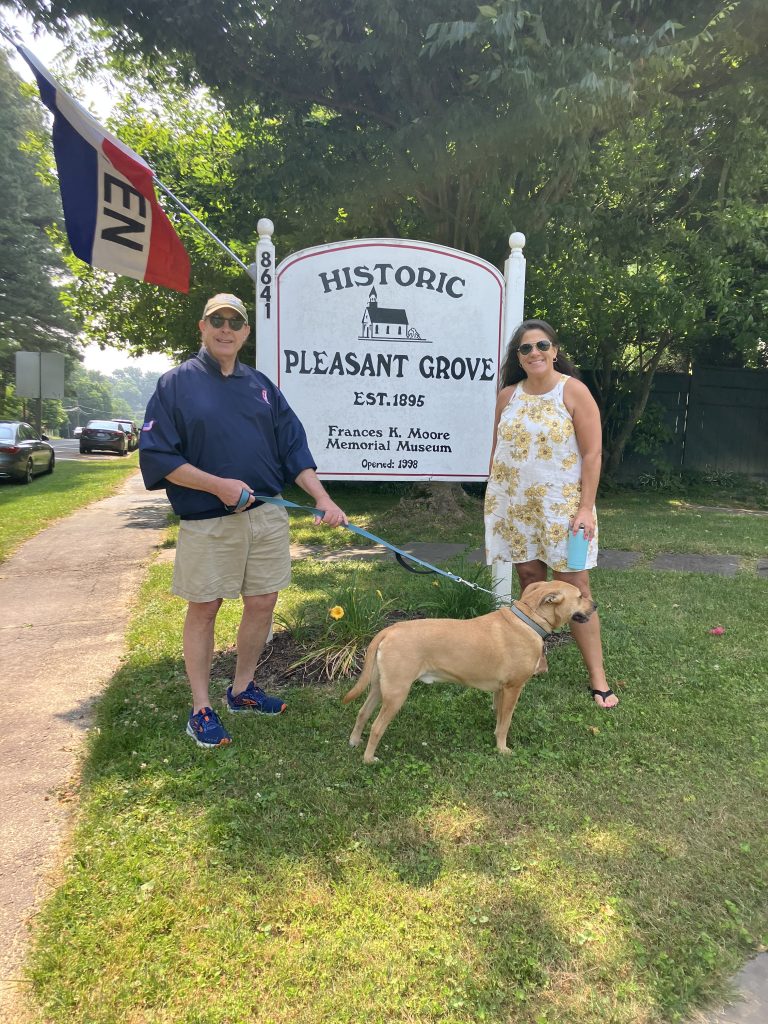
Pictured: Tyler Posey, Michelle Arcari and Scrappy Posey
To learn more about this historic gem in our midst and upcoming events public events planned at the site, I encourage you to visit Historic Pleasant Grove’s website at historicpleasantgrove.org/.
This blog post is the expressed opinion of its writer and does not necessarily reflect the views of Tysons Interfaith or its members.
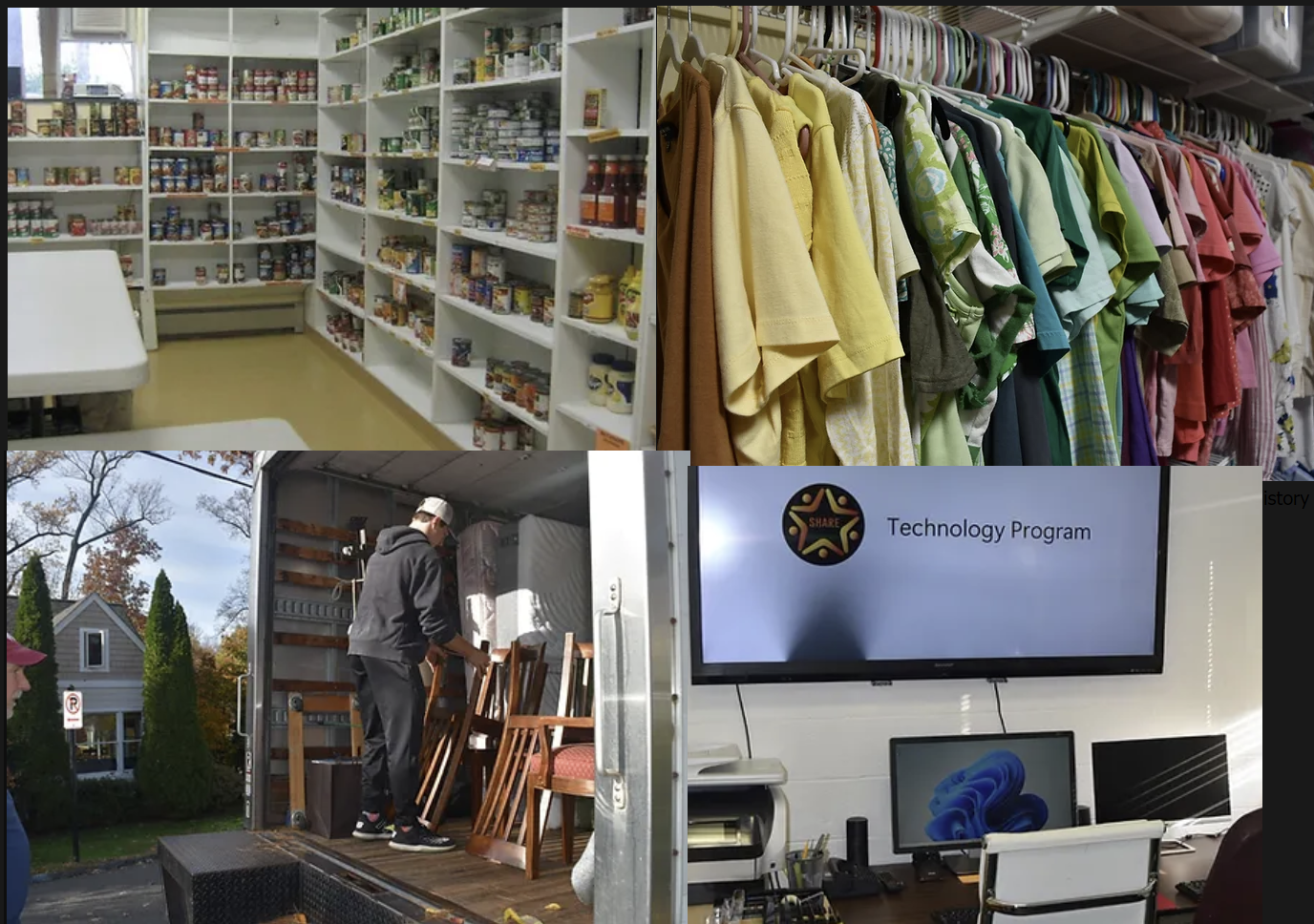
Tysons Interfaith is pleased to present a series of blog posts highlighting local non-profit organizations who are doing so much to help our neighbors. Please consider helping these groups with your time and resources. For a list of nonprofit organizations working in the Tysons area please visit: tysonsinterfaith.org/resources/
What is Share?
- Share Inc. is a 501 (c) (3) non-profit organization. To see our IRS Form 990 annual financial reports, click here.
- Though we are not religiously affiliated, we were established in 1969 by a coalition of local faith communities to help meet the emergency needs of our neighbors in McLean and the nearby areas of Northern Virginia.
- We are an all-volunteer organization with no paid staff, no office, and no paid fundraisers, therefore, nearly all donations directly benefit our neighbors in need.
- Share assistance includes a food pantry, clothing room, furniture program and family assistance program.
- We are supported by generous donations from local religious congregations, community organizations, neighborhood businesses and individuals. Our food and clothing rooms are housed is space donated by McLean Baptist Church.
- It currently takes more than 1000 volunteer hours per month to run our programs, so we are always recruiting new volunteers.
The Neighbors We Serve
- Our neighbors in need are economically distressed families and individuals, seniors living on limited incomes (often facing medical issues), new immigrants and victims of spousal abuse, as well as the homeless.
- The neighbors we serve are referred to us from participating faith communities, county social services, and a number of non-profit groups serving special need groups (such as victims of spousal abuse or the formerly homeless).
- Before being granted services, these neighbors are screened to ensure they fall within our service area and have an appropriate level of need.
- We serve the working poor, disabled persons, the homeless, recent immigrants and the elderly as well as those facing a crisis such as illness, job loss or other family emergency.
- Last year, we provided services to over 2,000 families including 4,500 household members, most of whom are children.
For information on how to volunteer or donate to Share of McLean, please visit shareofmclean.org

Most Needed Items
June 2023
FOOD:
Pasta (spaghetti, elbow, penne)
Canned tomatoes (diced, sauce)
Pasta sauce (cans or plastic jars)
Canned chicken
Peanut Butter (16 oz)
Canned fruit (fruit cocktail, peaches)
Canned corn
Canned beans (chickpea, pinto, kidney)
Vegetable oil (plastic jars: 24 oz, 48 oz)
PERSONAL CARE ITEMS:
Diapers (Sizes 5-7) and pull-ups (4T, 5T)
Adult diapers (all sizes, both genders)
Toilet paper / paper towels
Shampoo / Conditioner
Laundry detergent (20 – 40 loads)
Baby wipes
______________________________________________________
Please remember: NO GLASS, NO OVER-SIZED items, and no items past their “Best if Used By/Before” date.
Share would welcome re-usable grocery size bags, paper shopping bags with intact handles, and plastic grocery bags (used but intact).
Note: Share can accept refrigerated and frozen goods such as chicken, fresh produce, yogurt, cheeses, and eggs but only by prior arrangement (contact: sharevolunteers1367@gmail.com).
This blog post is the expressed opinion of its writer and does not necessarily reflect the views of Tysons Interfaith or its members.
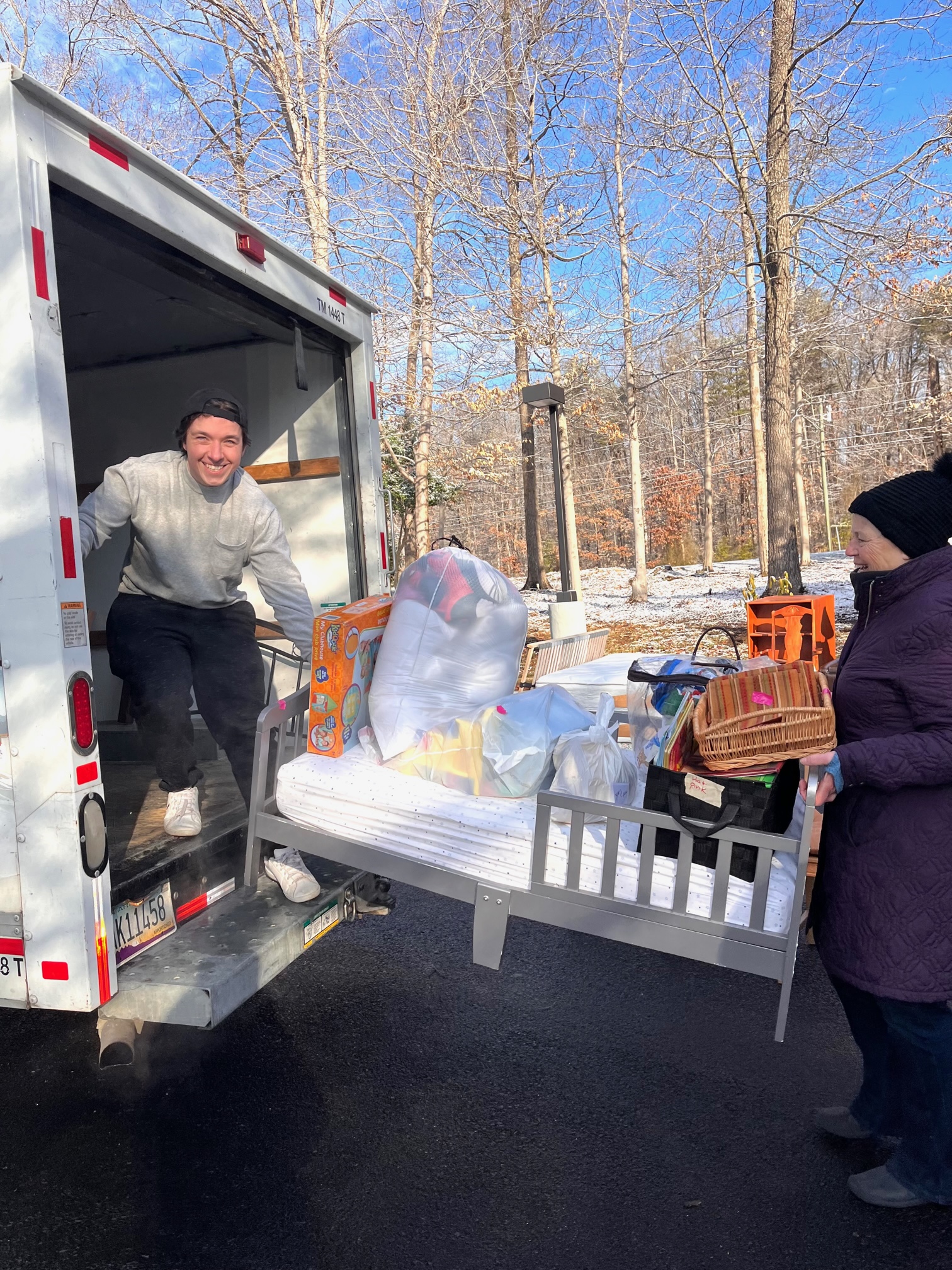
Tysons Interfaith is pleased to present a series of blog posts highlighting local non-profit organizations who are doing so much to help our neighbors. Please consider helping these groups with your time and resources. For a list of nonprofit organizations working in the Tysons area please visit: tysonsinterfaith.org/resources/
Gracing Spaces (former ministry of Lord of Life Lutheran Church), is now an independent local charity with a 501(c)(3) status.
When you grow up attending a Lutheran church, you often hear the phrase, “God’s work. Our hands.” Born into our identity as Lutherans is a desire to serve our neighbors out of love and obedience to the Lord. Gracing Spaces, a local volunteer organization that furnishes homes for families in transition, is one way that many of us feel called to serve.
Twenty years ago, a newly engaged Amanda Baumgart encouraged her mom to nix the traditional bridal shower and opt instead to renovate a room at a local halfway house. The attendees had such fun that they went back to give the entire house a makeover, deciding that this house could be the first of many. And it was—it was the first of thousands. A growing group of volunteers began to “grace spaces” in the northern Virginia community—coordinating with social workers to identify needs in the community and work to meet them.
Lord of Life Lutheran Church in Clifton, Virginia, loaned Gracing Spaces their unfinished basement which became “the depot.” Like a department store, the depot housed kitchen goods, linens, children’s clothes, tables, chairs, sofas, bookshelves, baby products, toys, beds, cleaning supplies—really anything that people were willing to donate that could “grace the space” of someone in need. A workshop was set up, so furniture was repaired instead of going to the landfill. Donors, often in times of grief and transition, walked away from the depot a little lighter, knowing the loved objects of their lives would find a good second home. For fourteen years, volunteers gathered every week to fill “orders”, working to coordinate furniture and add decorative touches to make sure spaces became homes. Vehicles that came into the parking lot empty went away full. On weekends (makeover days), empty spaces became homes.
In 2022, Lord of Life no longer felt that they could singly support Gracing Spaces since the ministry had grown profoundly over twenty years, so we had a decision to make—should we close up shop or evolve? Looking at the need in the community and knowing we could help, there really was no choice. We still had work to do—God still wanted our hands busy serving our neighbors.
A year later, we look a bit different. We have many “depots”—basements, garages, public storage units. We are independent, with a 501(c)(3) status and a board of directors. We have committees to help with fundraising and marketing. One thing is unchanged: our mission to give a “hand up” to the most vulnerable in our community by making their new spaces into homes.
Our biggest need is for a new “depot”, a donated or affordable warehouse where we can work and grow the ministry. After all, furniture takes up space! We are fundraising seed money to rent a property, so financial contributions and new partners in ministry (https://www.gracingspaces.com/donate-money) are a wonderful blessing to our organization as well.
For twenty years, we have found great joy in moving goods from where they are no longer needed into places where they are. We pray for another twenty years, knowing our community is stronger when we care for one another.
Love and serve without distinction all earth’s people, first and least,
Know within each act of kindness, hope and wholeness are increased.
“See my hands and feet,” said Jesus, love arisen from the grave.
“Be my hands and feet,” said Jesus, “live as ones I died to save.”
–“See My Hands and Feet” by Mary Louise Bringle

This blog post is the expressed opinion of its writer and does not necessarily reflect the views of Tysons Interfaith or its members.

An article I read from the Stanford Center for Longevity notes that there is a relationship between volunteering and improved physical health and cognitive function. “Research also shows that volunteers report elevated mood and less depression, and that volunteers report increased social interactions and social support, better relationship quality, and decreased loneliness.” longevity.stanford.edu A contributor to Deseret News had this to say about her volunteer experience: “I’ve experienced the boost in happiness, the sense that I was part of something bigger. I made friends, formed connections that I still have to this day, and I felt more optimistic about the world when I was surrounded by people who, like me, were trying to help others.” deseret.com/coronavirus/2022/4/17.
Of course, volunteering strengthens communities as well. As people of different backgrounds come together to serve our neighbors, we discover that we have much more in common than we ever imagined. Whether it is donating our time, talents or resources, each selfless act truly does help make the world a better place.
Want to learn more about some of the non-profits doing phenomenal work in the Tysons area? Spring and summer 2023, Tysons Interfaith will present a series of blog posts highlighting local organizations that are working to improve the lives of our neighbors. Please look for these periodic posts, or feel free to visit the Tysons Interfaith Resources Page for a comprehensive list of non-profit organizations in our area: tysonsinterfaith.org/resources.
This blog post is the expressed opinion of its writer and does not necessarily reflect the views of Tysons Interfaith or its members.
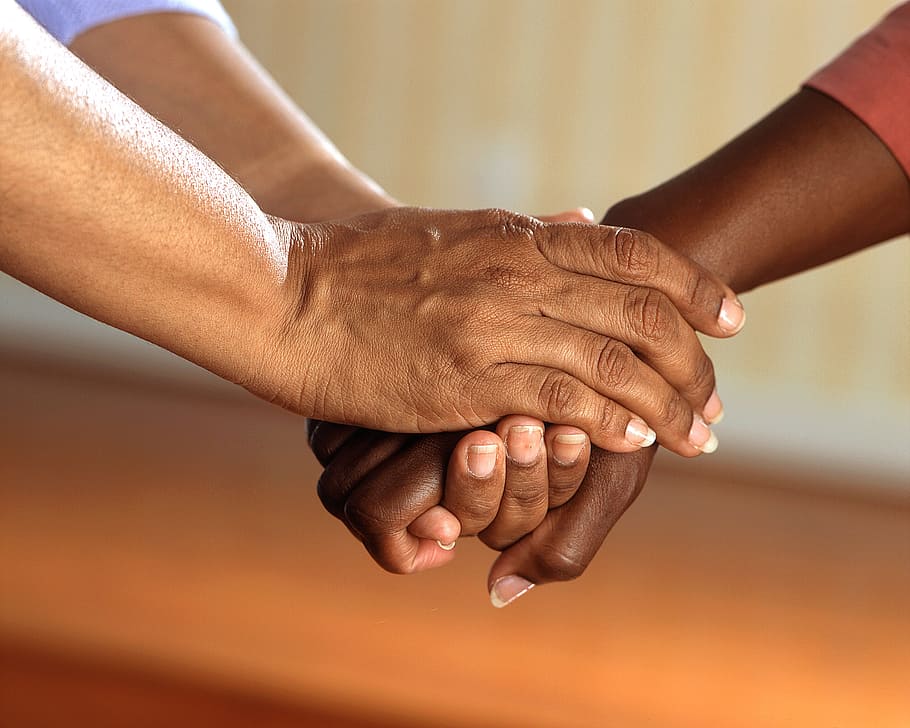
What is your “worldview”? What do you hold dear? The answers to these questions are both the composite and the creator of your attitudes, values, stories, and expectations about your world and the world around you. They inform your every thought and action. Your worldview manifests as your ethics, religion, philosophy, and beliefs.
We arise from our cultures of origin, so we are a product of that culture, and we have everything that is necessary to be the producers of new cultures. Humans have been creating cultures since we first walked the earth.
Are you a “glass-half-full” person – an optimist that sees the positive in everything, or a “glass-half-empty” pessimist that goes to the darker side, thinking the worst of any situation? Most of us vacillate between the two depending on context.
If you had magical powers (which, of course, you do), what culture would you create? Would it be utopian? Would everyone get along without challenges or disagreements? Would it be so peaceful that terminal stasis might set in? Or would it be a world in which citizens are truly free to think independently, to share the breadth of their creativity, to debate respectfully, challenge other’s opinions without fear, collectively focusing on solutions and constructive evolution? Could a world of health, harmony, and unconditional high regard that supports everyone in living their best yet to be, prevail?
Thousands of people gathering in small groups are responding to the heart-call to create a world that works. In the interfaith world, we are creating a culture of connection that begins with compassionate curiosity. We are concerned about others’ experiences and encourage everyone to learn with and from one another. Kindness, stemming from mutual respect, is blossoming. Curiosity, which plays a huge role in how we relate to our world, is the strong desire to learn something more, something new. Our willingness to reach beyond the culture in which we were raised depends on our internal sense of safety blended with the divine urge to experience the unknown. Our culture of origin instilled acceptable and customary beliefs and social forms and formulas in us. We unconsciously embraced the material traits of our racial, religious and social groups. This worldview has out-pictured as our everyday existence – our way of life and the people with whom we share our lives. It is how we relate to all creation, our chosen diversions, the places we reside and our travels. As years have passed, some have stayed deeply linked to those original perspectives. Most of us have evolved, some more than others.
Some people look at the world and see it fractured, fragmented into myriad separate pieces. All they see are differences: different skin color, different size, shape, ethnicity, religion … different climates, different architecture. Different everything. Theirs is a world of “me and us” versus “other” – constantly contrasting what they believe to be known and safe with all that is different. The leap to an assumption that “different is dangerous” is all too easy. Gripped in fear, “fight, flight or freeze” instinctive, defensive reactions take over. Resourcefulness disappears.
Others, drawn by our common human desire to connect, may be challenged to find ways to relate to those individuals and groups that don’t align with our worldview. When confronted with personalities and appearances unlike ours, we may fumble and experience a jumble of emotions, yet continue to pursue connection. We experiment. Some of our tries turn out to be life-affirming and others quite opposite, and we don’t give up. We look around and note in awe and wonder, the myriad distinction of creation in expression. We drink in commonalities and celebrate all the differences. We recognize that we are looking at the same world through different subjective filters.
Commonalities prevail throughout nature. We are all made of the same stuff. For the most part, it is only when personality, rather than physicality, is brought into the equation that concerns about “different” crop up. Distinctions within commonalities are what make Life rich. Innate distinctions are what express as myriad appearances, gifts, talents, and desires.
The tension of opposites – the pull and push of life – stirs creativity. New solutions, new ways of being together are revealed. The Divine Urge within each of us desires to resolve conflict and harmonize our world. Coming together across myriad cultures and faith traditions, contemplating co-existence, I hear within me, Elizabeth Barrett Browning’s “How do I love thee? Let me count the ways.” What if we were to ask, “What do we have in common? Let me count the ways.” I am sure we would discover ways to love one another. And, what if in love, we were to ask, “Tell me how it is to be you, your life, and those you love.”
Ernest Holmes shared what won’t work: “You cannot draw love into your consciousness through hate. You cannot draw peace from confusion. You cannot see beauty through ugliness, nor hear harmony while your ears are filled with discord.” So what will work?
We must develop a Culture of Connection! It may be easier than you think, here are some simple steps:
- Embrace your desire to create a Culture of Connection and commit to doing your part
- Set your intention to consistently be present in your conversations
- Silence our fear-mongering self-talk to the best of your ability
- Enter a consciousness of Love because it is contagious
- Express genuine, compassionate curiosity
- Initiate conversations – talk to strangers even though your mother told you not to.
This blog post is the expressed opinion of its writer and does not necessarily reflect the views of Tysons Interfaith or its members.
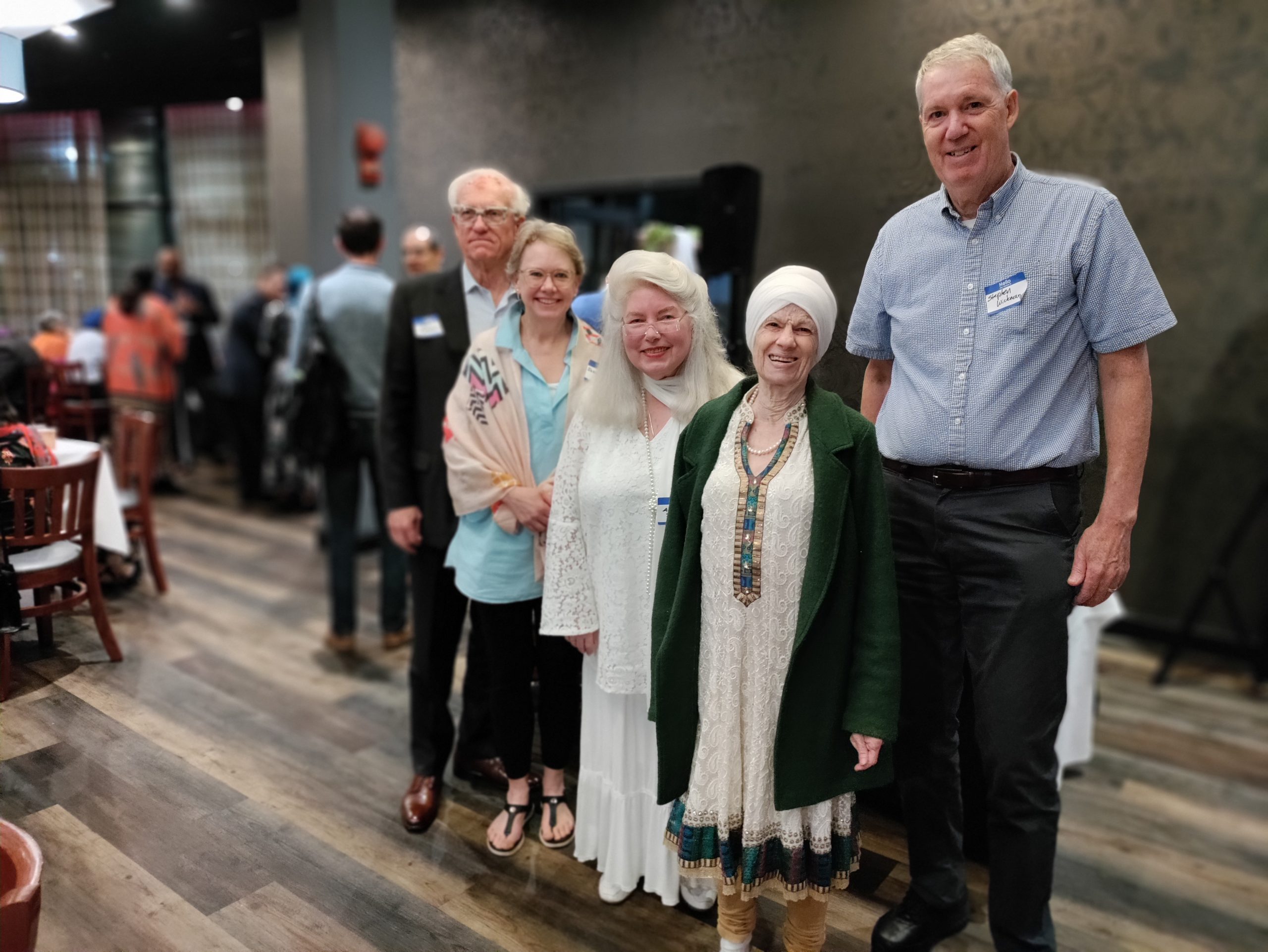
The holy month of Ramadan came to a close on April 21st.
During this period, our brothers and sisters in the northern Virginia Muslim community hosted several Interfaith Iftars. An Iftar is a meal taken at sundown to break the daily fast that occurs during Ramadan.
Our Muslim friends invited people of all faith traditions to join them for this special meal for fellowship and to learn more about Islam and the meaning of Ramadan. Interfaith Iftars were hosted by the Dar Al Hijrah Islamic Center, the American Turkish Friendship Society and by the McLean Islamic Center in conjunction with the Jewish Islamic Dialogue Society of Washington (JIDS). There may have been others, but these were the ones known to me.
I was honored to attend the Interfaith Iftar hosted by the McLean Islamic Center/Jewish Islamic Dialogue Society of Washington (JIDS). We heard a panel discussion led by member of the Muslim and Jewish communities, enjoyed conversing with people from different faith traditions, and dined on delicious food prepared by the Bombay Tandoor Restaurant.
Gatherings such as these remind me of why my participation with Tysons Interfaith is so meaningful in my life. What a privilege it is to learn more about how people of other faith traditions experience and worship God and to be in community with people who respect and honor the spiritual practices of their neighbors. Please consider joining us! tysonsinterfaith.org
The following photo was taken at the McLean Islamic Center/Jewish Islamic Dialogue Society Iftar on April 16, 2023. Representing Tysons Interfaith and their faith communities at the event (left to right): Bill Larson, Emmanuel Lutheran; Susan Posey, Redeemer Lutheran; Andra Baylus, the Meher Baba Spiritual Community; Adarsh Khalsa, the Sikh Community; and Stephen Wickman, St. Thomas Episcopal.
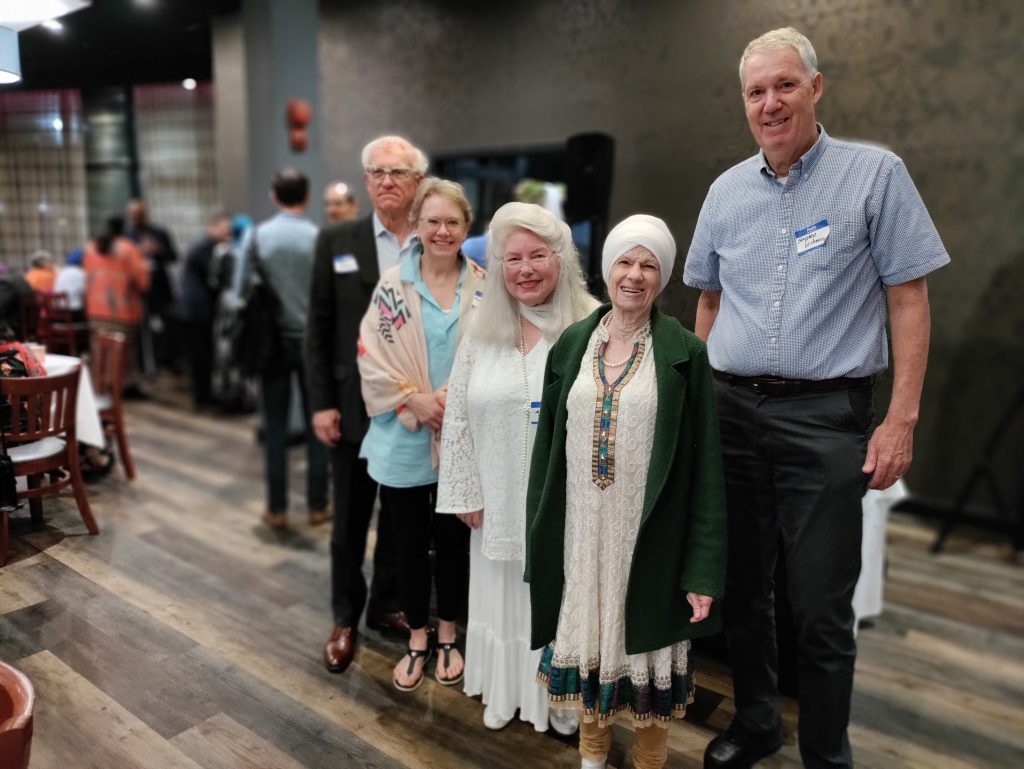
This blog post is the expressed opinion of its writer and does not necessarily reflect the views of Tysons Interfaith or its members.

Tysons Interfaith is honored to present this blog post (with date revisions) first published in 2022:
The Jewish holiday of Passover occurs every spring, as surely as the daffodils bloom, and it is perhaps the most central in terms of Jewish life and history.
The holiday begins at sunset (as do all Jewish holidays) on the 15th of the Hebrew month of Nissan. Because the Hebrew calendar is based on a lunar system, with 28 days in a month, corrected 7 times in a 19-year cycle by adding a leap month, the holidays can only move on the Gregorian calendar from late March to late April, this year beginning on Wednesday, April 5th.
Passover celebrates the biblical account of the Israelites’ redemption and escape from 400 years of Egyptian slavery. The story is told in the Book of Exodus, but many only know of the parting of the Red Sea. The story unfolds with the Israelites as slaves and the long attempt to be set free. Even before this freedom happens, in Exodus 12:14 the Almighty is describing a holiday and how to celebrate it: “This day shall be to you one of remembrance: you shall celebrate it as a festival to the Eternal throughout the ages; you shall celebrate it as an institution for all time. 12:15 Seven days you shall eat unleavened bread; on the very first day you shall remove leavening from your house ….”.
The unleavened bread is Matzah and is central to the celebration of the holiday.
Passover is celebrated with a special meal called the Seder, where family and friends gather to read from the Haggadah which relates the story of Passover, the Israelites leaving Egypt and going from slavery to freedom. On the Seder table is a special plate which contains food, symbolic for the holiday. There you will find a roasted lamb shank bone symbolizing a sacrifice at the Temple in Jerusalem, a roasted egg, a sacrifice brought by the pilgrims, parsley symbolizing spring, Charoset (made from apples, nuts and wine) symbolizing the clay that was used by the slaves to make bricks for Pharaoh, horseradish symbolizing the bitterness of slavery and romaine lettuce, another bitter reminder. In addition to telling the story, there is singing, a bountiful meal and the warmth and closeness only family and friends can bring.
Sources:
https://reformjudaism.org/jewish-holidays/passover/passover-history
unitedwithisrael.org/the-foods-on-the-seder-plate-and-the-symbolism
The Torah, a Modern Commentary
Celebrating and Creating Traditions, Passover Recipes and Ideas
This blog post is the expressed opinion of its writer and does not necessarily reflect the views of Tysons Interfaith or its members.
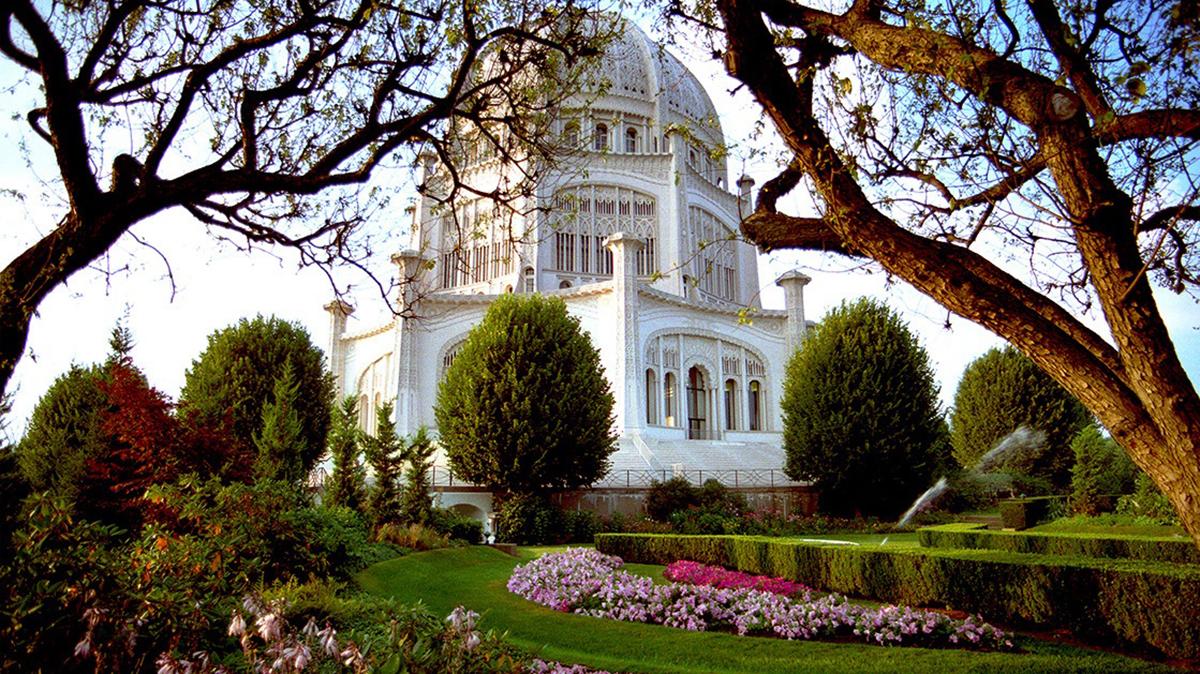
People of the Baha’i faith celebrated Naw-Ruz earlier this week. We hope you enjoy this repost discussing Baha’i spring observations:
Probably many people know that Easter and Passover occur in the spring, but spring is also a time of sacred observation for people of the Baha’i Faith.
March 20- 21 are the Baha’i Holy Days of Naw-Ruz, the Baha’i New Year. Naw-Ruz
coincides with the spring equinox and is an ancient Persian festival celebrating the “new day.” For Baha’is it marks the end of the annual nineteen-day fast and is one of the nine holy days of the year when work is suspended, and children are exempted from attending school.
Also in the spring is the Festival of Ridvan. This annual Baha’i festival commemorates the twelve days when Baha’u’llah, the founder of the Baha’i Faith, publicly proclaimed His mission as God’s messenger for this age. Elections for local, national, and international Baha’i institutions are generally held during the Festival of Ridvan. The first day (April 20 or 21), the ninth day (April 28 or 28), and the twelfth day (May 1 or 2) are celebrated as holy days when work is suspended, and children are exempted from attending school.
To learn more about the Baha’i Faith, please visit: www.bahai.org
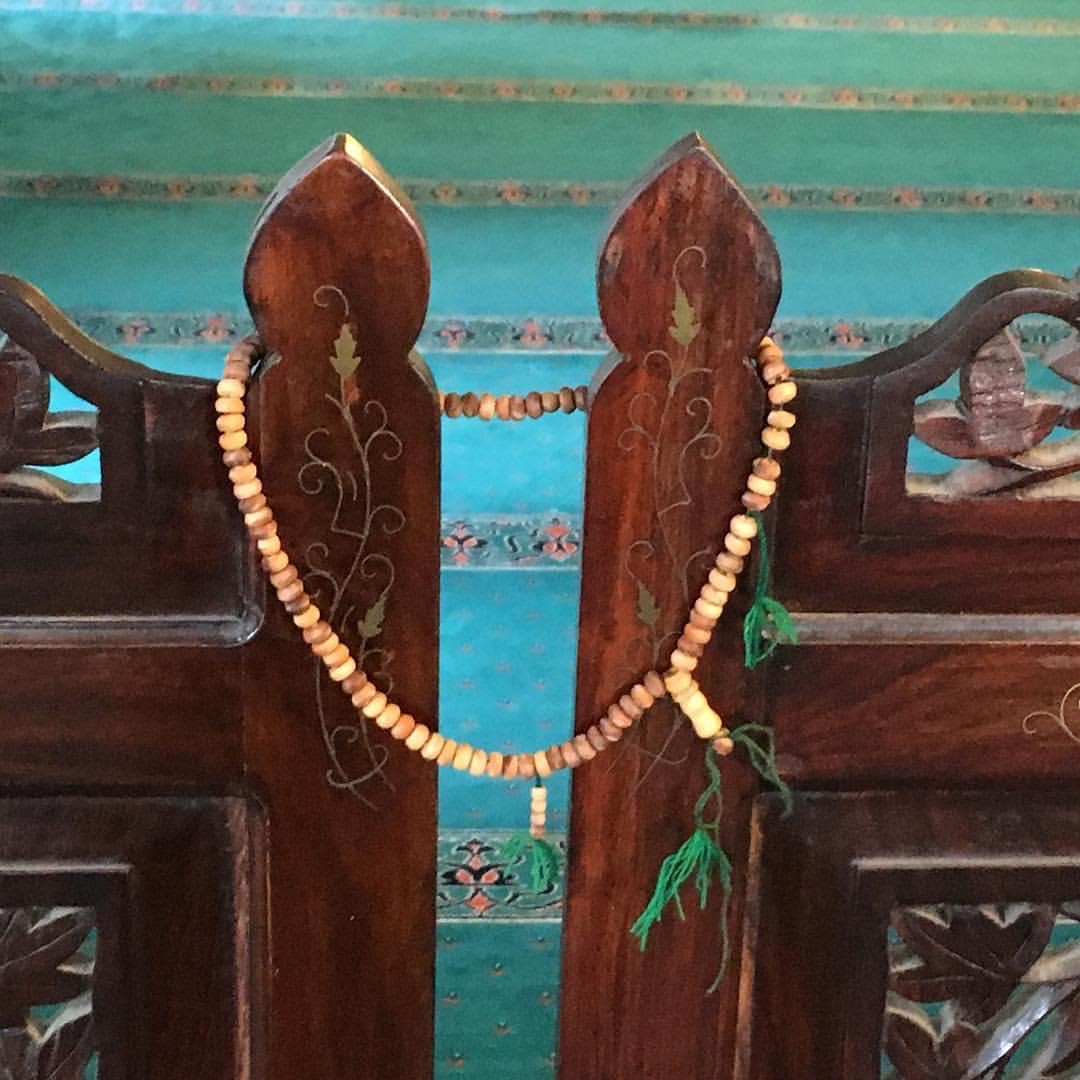
The holy month of Ramadan is expected to begin on Wednesday, March 22 at sunset.
To our brothers and sisters in the Muslim community, we say Ramadan Mubarak.
In honor of this special time, we are pleased to share with you this poem, written by Yerusalem Work of the Dar Al Hijrah Islamic Center:
Ramadan Rumination
Awakened
in an atmosphere of fear, hope, and love,
I seek refuge in a profound truth that
Allah pardons and protects those in need of
mercy and compassion,
kindness and the process of peace.
Humanity aligns with You when prostrate
on a prayer rug with niyah
and facing the qibla.
A perfect rain descends
and our hearts You mend.
May our prayers rise above
the fitnah of this world until
unity is a living dream
that we see as reality
and belief strengthens us
on a path He knows is best
that leads to Paradise –
nothing less.
May our worship be reserved for the One
who bleeds no blood,
but Whose words we hold in our hands
and recite according to His plan.
We thank You for the glorious Qur’an.
This blog post is the expressed opinion of its writer and does not necessarily reflect the views of Tysons Interfaith or its members. Photo credit to Yerusalem Work.
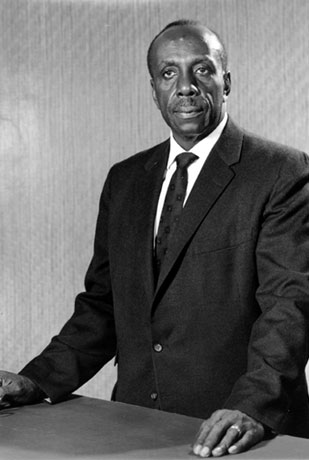
In recognition of Black History Month, I commend to you this prayer by Howard Thurman:
Lord, Lord, Open Unto Me
Open unto me, light for my darkness
Open unto me, courage for my fear
Open unto me, hope for my despair
Open unto me, peace for my turmoil
Open unto me, joy for my sorrow
Open unto me, strength for my weakness
Open unto me, wisdom for my confusion
Open unto me, forgiveness for my sins
Open unto me, tenderness for my toughness
Open unto me, love for my hates
Open unto me, Thy Self for myself
Lord, Lord, open unto me!
Thurman was born in 1899 and raised in the segregated South. He is recognized as one of the great spiritual leaders of the 20th century renowned for his reflections on humanity and our relationship with God. Thurman was a prolific author (writing at least 20 books); perhaps the most famous is Jesus and the Disinherited (1949), which deeply influenced Martin Luther King, Jr. and other leaders of the Civil Rights Movement. Thurman was the first black person to be a tenured Dean at a PWI (Boston U). He also cofounded the first interracially pastored, intercultural church in the US.
Source: https://www.xavier.edu/jesuitresource/online-resources/prayer-index/prayers-for-black-history-month1
This blog post is the expressed opinion of its writer and does not necessarily reflect the views of Tysons Interfaith or its members.
